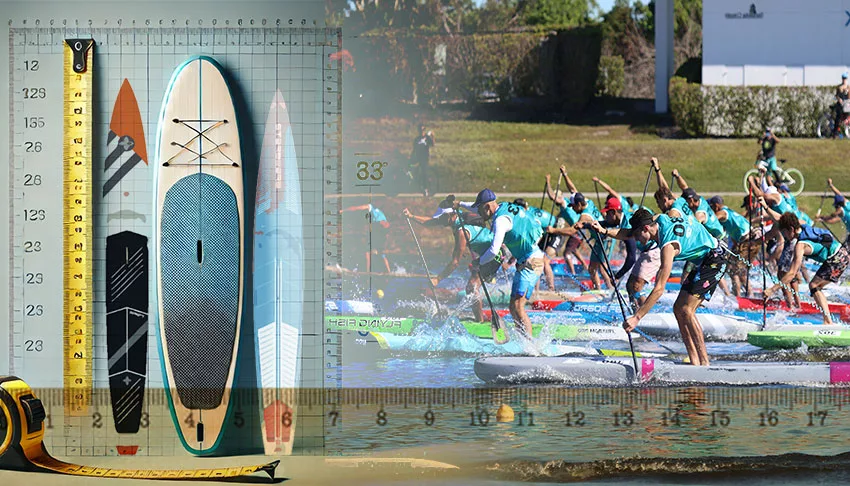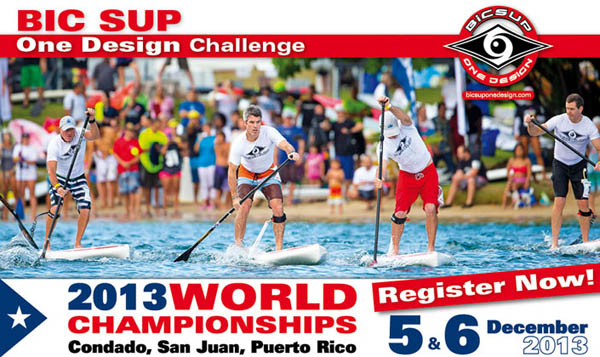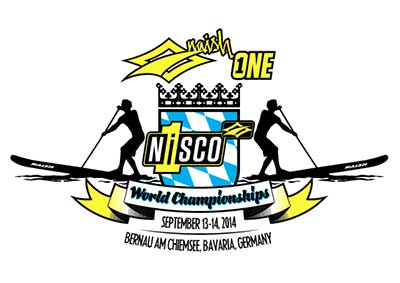
Editorial by publisher Mike Jucker
During a recent visit to Maui, we had the chance to spend some time with Juliette Duhaime. Not only did we sit down for a great interview, but we also took her along for some local wingfoil sessions. On the car ride, an interesting topic came up: Raceboard length.
Juliette mentioned that there’s some chatter in the community about whether the established 14′ standard should be reconsidered. She made some solid points in favor of shorter Raceboards — for example, around 9’6″, or basically anything under 10 feet — especially when it comes to the practicality of air travel.
This really caught my attention because I witnessed the birth of the 14′ standard about a decade ago. Back then, SUP racing was still mostly an ocean sport with a strong downwind component. We had the Unlimited Class, the Stock (14′) class, and the 12’6″ class, which eventually faded away. I clearly remember the heated debates and proposed restrictions. SUP Racer Chris Parker was right in the middle of it all back in 2014 — [have a look here].
At the time, the discussion only started because the longest blanks available to shapers were 12’6″, and many of the popular brands worked within that limit. Of course, longer boards proved faster, especially the Unlimited boards designed for long-distance downwind racing. In short, the sport was still so young that there wasn’t any unified board class — it was pretty much a free-for-all.
Before we revisit the actual topic and ask if it would be practical to change to a shorter standard we look at the history.
Early Battle of the Paddle Days (2008–2013)
Origin of 12’6: The Battle of the Paddle (BOP) set a 12’6 max for its Elite race in 2008 so existing popular boards (e.g., a 12’1 Laird/Surftech) could enter; they literally measured on the beach and even sawed tips off a few boards to comply. Check this article by SUP Racer from 2012. As racing grew, the WPA formalized 12’6, 14’ and Unlimited classes (men & women), which helped standardize US events. The WPA is the World Paddle Association, which is a bit of an enigma. We have not heard anything from this One-Man organization in years and doubt it has still any relevancy.
For all of you who are interested, this is the last time we met Kurt Byron, the man behind the WPA. It was 2019 at the Gorge Paddle Challenge and already back then we could not quite make sense of it all. The ICF was just about to get established and we looked back at 6 years of ISA governing the sport internationally.
To this day the WPA has a website that is up to date.
Then later on came the Gender split idea: A 2013 discussion asked whether women should race 12’6 while men raced 14’. This discussion of obviously behind us but for all SUP History fans here is another article by Chris Parker on SUP Racer
The big arguments (2013–2016)
After a while another topic surfaced: Fairness & inclusivity. Many pros and organizers asked if 14’ is more inclusive across paddler sizes/weights and conditions, versus 12’6 potentially penalizing bigger paddlers. There was a good article in 2015 on SUP Racer written by Dr. Bryce Dyer who took a closer look on what would be feasible board class. There were many scenarios in this article and now 10 years later it is almost hilarious to read through it all.
Also hilarious was the The Stand Up Paddle Athletes Association (SUPAA) that pushed design limits (min waterline widths, weight minimums, recess depth) to keep boards stable/affordable and avoid a narrow, expensive “balance contest.” The SUPAA was a very short lived association spear headed by Chase Kosterlitz a dominant force in SUP Racing back then. The SUPAA never took off and it turned out it was more about the book promotion than an actual unification of the sport. The SUPAA back then proposed limits including ~23–23.75″ waterline widths and 9–10 kg minimum weights. You can read all about this again on SUP Racer from 2014.
The problems remained: Travel & logistics. Some defended 12’6 as easier to fly with, but by 2016 critics called the “airline argument” largely debunked—most airlines didn’t treat 12’6 and 14’ differently (both were tough). In 2016 the Pacific Paddle Games tried to revert back to the 12’6″ after things seem to have cooled off. It was Chris Parker who again stirred the pot on SUP Racer making some good argument, but it was clear that people were getting tired of this debate:
The ‘board class debate’ has been raging through the SUP community over the past half a decade like a wildfire, with some passionately supporting the 12’6 and others pushing for a 14′ standard. Opinion is split, with rival events, athletes and organisations all pushing their own egos and agendas. – Chris Parker –
Where it landed around 2017
Around 2017 the 14’ became the de facto standard (esp. for men): By early 2017, data showed 14’ dominated participation (≈¾ of men on 14’ at major races like Carolina, the Gorge, EuroTour, and many AUS events). Chris Parker seemed visibly relieved:
To say I’m a little tired of the whole 12’6 vs 14′ board class debate would be an understatement – I think we should be discussing far more important topics such as how to grow grassroots participation and make elite races more exciting – but I was recently asked by a few big events to produce some stats on 12’6 vs 14, so here they are.
Read his full statement on SUP Racer
However the rules still allowed both: ISA’s 2017 rulebook explicitly listed 12’6 and 14’ classes and even specified 12’6-and-under equipment for certain race formats, reflecting ongoing regional variance.
Why 14’ “won”
Performance with access: For similar stability, paddlers can go narrower at 14’ and gain glide/versatility across flat/chop/downwind, which many saw as fairer to a wider range of body sizes.
Simplicity for racers/brands: A single go-to length reduces quiver costs and confusion for events, brands, and athletes. While 12’6 remained common for tech/beach racing and juniors the march forward of the 14′ could not be stopped and soon it became the standard length for all SUP Races. The 12’6″ board length has pretty much disappeared, yet not everybody is happy with the 14′.
What we did not note in the history above was that at least 2 brands tried to start a One-Design class. It was Naish and BIC how tried to push this topic, BIC on hardboard and Naish on inflatables with the N1SCO. Both ideas did not survive more than 3 years.


This is the history of why we predominantly race on 14′ boards. Now let’s get back to the question that came up with Juliette Duhaime. Her pro arguments were pretty clear: A sub-10′ hardboard would be much easier to travel with and far more versatile.
I responded: if convenient travel is such a big point, then why not just race on inflatables? Imagine being able to travel to any race in the world with your board packed into a backpack. Juliette was clearly not in favor of this idea — and to be clear, neither am I. SUP races belong on hardboards. But from a purely practical standpoint, nothing beats the iSUP.
That said, I have serious doubts that after almost a decade of having an agreed-upon raceboard standard, things could be rolled back to 12’6″ or even 9’6″. There are too many questions, and given how fragmented the sport is, bringing all stakeholders to the table would be nearly impossible.
All companies still in the raceboard business are producing 14′ boards, and they would need to change their production relatively quickly. Not to mention the many people who have already invested in 14′ boards for recreational or competitive use — would they really be willing to buy a new raceboard? I’m not so sure.
Shorter boards would also reignite the debate around rider weight and board width. Smaller and lighter athletes would once again have a disproportionate advantage over others. Of course, this argument still exists with 14′ boards, but at least they provide enough volume to support a wider range of weight classes.
Why not return to a One-Design Class?
Once a sport enters the Olympics, a one-design class will be implemented, leveling the playing field. For example, Starboard has already introduced a one-design foil and board class for wingfoil races. We’ve also seen this experiment in SUP, and we know how far it went.
The only way this could really work is if SUP racing became an Olympic discipline, or if someone launched a world tour based on a one-design class, with boards provided at every location. That would be fantastic in some ways, but it would also remove the incentive for board companies to continue developing new designs and supporting their team riders. The original one-design idea from over ten years ago was intended to attract more people to the sport — not to serve as a platform for elite racing. That’s why I don’t see a revival of one-design in SUP, except perhaps in the distant future if the sport makes it to the Olympics for that one race.
Conclusion
For me, the essential conclusion is to leave things as they are. Let brands continue developing faster and better shapes, encourage event organizers to get involved in board transport, and provide rentals for athletes who prefer to travel light. Trying to change equipment standards now would create more problems than it solves — especially when SUP racing has so many other issues that need addressing first.
Do you think it is good that we pick up topics like this and contribute to the community with inspiring thoughts and opinions? If so, please become supporter of our work.
Online Subscription
Are you enjoying the content of the Stand Up Magazin?
With a subscription, you help secure the future of Stand Up Magazin.
Become a patron and supporter with your subscription.
Your subscription is an annual contribution and renews automatically.


